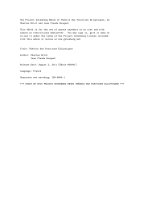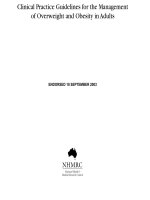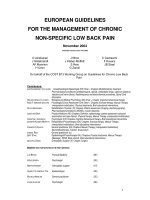GUIDELINES FOR THE USE OF SOCIAL MEDIA doc
Bạn đang xem bản rút gọn của tài liệu. Xem và tải ngay bản đầy đủ của tài liệu tại đây (397.76 KB, 7 trang )
GUIDELINES
FOR THE USE OF
SOCIAL MEDIA
January 2010
Revised July 2010
Prepared by: e Voices Technology and Best Practice Team
TABLE OF CONTENTS
Overview of Document 2
General Rules to Follow 3
Social Media Guidelines when Posting as an Individual 4
Social Media Guidelines When Posting on Behalf of the University of Michigan 5
Safety Tips for Social Media Networking 6
Overview
is document was originally developed to provide a set of guidelines in the use of social media applications within VOICES Community,
but we believe it has wider application for the University of Michigan. e rapid growth of social media technologies combined with
their ease of use and pervasiveness make them attractive channels of communication. However, these tools also hold the possibility of a
host of unintended consequences. To help you identify and avoid potential issues we have compiled these guidelines. ey are examples
of best practices from various institutions and are intended to help you understand, from a wide range of perspectives, the implications of
participation in social media.
Things to Consider When Beginning to Use Social Media
Applications that allow you to interact with others online (e.g. Facebook, MySpace, etc.) require careful consideration to assess the
implications of “friending,” “linking, ” “following” or accepting such a request from another person. For example, there is the potential
for misinterpretation of the relationship or the potential of sharing protected information. Relationships such as faculty-student, doctor-
patient, supervisor-subordinate and sta-student merit close consideration of the implications and the nature of the social interaction.
e following are some guidelines to follow in these cases.
2.
GENERAL GUIDELINES
Sharing U-M news, events or promoting faculty and student work
through social media tools is an excellent, low-cost way to engage
the community and build our brand. Employees are encouraged
to repost and share information with their family and friends that
is available to the public (press releases, articles in the University
Record, Internet news, etc.). e best way to share university news
is to link to the original source. When sharing information that is
not a matter of public record, please follow the below guidelines.
Maintain Condentiality
Do not post condential or proprietary information about the
University of Michigan, its students, its alumni or your fellow
employees. Use good ethical judgment and follow university
policies and federal requirements, such as the Health Insurance
Portability and Accountability Act (HIPAA) of 1996 and the Family
Educational Rights and Privacy Act (FERPA). Review www.med.
umich.edu/news/newsroom/privacy.htm for HIPAA requirements
and www.ogc.umich.edu/faq_student.html for FERPA. Review
for more on your
responsibility as a U-M employee.
Maintain Privacy
Do not discuss a situation involving named or pictured individuals
on a social media site without their permission. As a guideline, do
not post anything that you would not present in any public forum.
Additional information on the appropriate handling of student,
employee and patient information can be found at: http://www.
mais.umich.edu/access/download/ja_access_compliance.pdf
Respect University Time and Property
It’s appropriate to post at work if your comments are directly related
to accomplishing work goals, such as seeking sources for information
or working with others to resolve a problem. You should participate
in personal social media conversations on your own time and in
accordance with the Standard Practice Guide 520.1.
Do No Harm
Let your Internet social networking do no harm to the University of
Michigan or to yourself whether you’re navigating those networks
on the job or o.
Understand Your Personal Responsibility.
U-M sta and faculty are personally responsible for the content they
publish on blogs, wikis or any other form of user-generated content.
Be mindful that what you publish will be public for a long time—
protect your privacy.
Be Aware of Liability
You are responsible for what you post on your own site and on
the sites of others. Individual bloggers have been held liable for
commentary deemed to be copyright infringement, defamatory,
proprietary, libelous, or obscene (as dened by the courts).
Increasingly, employers are conducting Web searches on job
candidates before extending oers. Be sure that what you post today
will not come back to haunt you.
Maintain Transparency
e line between professional and personal business is sometimes
blurred: Be thoughtful about your posting’s content and potential
audiences. Be honest about your identity. In personal posts, you
may identify yourself as a U-M faculty or sta member. However,
please be clear that you are sharing your views as an individual, not
as a representative of the University of Michigan.
Correct Mistakes
If you make a mistake, admit it. Be upfront and be quick with your
correction. If you’re posting to a blog, you may choose to modify an
earlier post—just make it clear that you have done so.
Respect Others
You are more likely to achieve your goals or sway others to your
beliefs if you are constructive and respectful while discussing a bad
experience or disagreeing with a concept or person.
Be a Valued Member
If you join a social network, make sure you are contributing
valuable insights. Don’t hijack the discussion and redirect by posting
self/organizational promoting information. Self-promoting behavior
is viewed negatively and can lead to you being banned from Web
sites or groups.
Think Before You Post
ere’s no such thing as a “private” social media site. Search engines
can turn up posts and pictures years after the publication date.
Comments can be forwarded or copied. Archival systems save
information even if you delete a post. If you feel angry or passionate
about a subject, it’s wise to delay posting until you are calm and clear-
headed. Post only pictures that you would be comfortable sharing
with the general public (current and future peers, employers, etc.).
3.
SOCIAL MEDIA GUIDELINES WHEN
POSTING AS AN INDIVIDUAL
U-M uses social media to supplement traditional press and
marketing eorts. Employees are encouraged to share university
news and events, which are a matter of public record, with their
family and friends. Linking straight to the information source is
an eective way to help promote the mission of the University
and build community. When you might be perceived online as
an agent/expert of U-M, you need to make sure it is clear to the
audience that you are not representing the position of U-M or U-M
policy. While the guidelines below apply only to those instances
where there is the potential for confusion about your role as a U-M
agent/expert versus personal opinion, they are good to keep in mind
for all social media interactions. When posting to a social media site
you should:
Be Authentic
Be honest about your identity. In personal posts, you may identify
yourself as a U-M faculty or sta member. However, please be clear
that you are sharing your personal views and are not speaking as a
formal representative of U-M. If you identify yourself as a member
of the U-M community, ensure your prole and related content are
consistent with how you wish to present yourself to colleagues.
1
Use a Disclaimer
If you publish content to any website outside of U-M and it has
something to do with the work you do or subjects associated with
U-M, use a disclaimer such as this: “e postings on this site are my
own and do not represent U-M’s positions, strategies or opinions.”
Don’t Use the U-M Logo or Make Endorsements
Do not use the U-M block M, wordmark, athletic logo or any other
U-M marks or images on your personal online sites. Do not use
U-M’s name to promote or endorse any product, cause or political
party or candidate. U-M logo and trademark guidelines can be
found at: />Take the High Ground
If you identify your aliation with U-M in your comments, readers
may associate you with the university, even with the disclaimer that
your views are your own. Remember that you’re most likely to build
a high-quality following if you discuss ideas and situations civilly.
Don’t pick ghts online.
Don’t Use Pseudonyms
Never pretend to be someone else. Tracking tools enable supposedly
anonymous posts to be traced back to their authors.
Protect Your Identity
While you should be honest about yourself, don’t provide personal
information that scam artists or identity thieves could use. Don’t list
your home address or telephone number. It is a good idea to create a
separate e-mail address that is used only with social media sites.
Does it Pass the Publicity Test
If the content of your message would not be acceptable for face-to-
face conversation, over the telephone, or in another medium, it will
not be acceptable for a social networking site. Ask yourself, would I
want to see this published in the newspaper or posted on a billboard
tomorrow or ten years from now?
Respect Your Audience
Don’t use ethnic slurs, personal insults, obscenity, or engage in
any conduct that would not be acceptable in U-M’s community.
You should also show proper consideration for others’ privacy and
for topics that may be considered sensitive —such as politics and
religion.
Monitor Comments
Most people who maintain social media sites welcome comments—
it builds credibility and community. However, you may be able
to set your site so that you can review and approve comments
before they appear. is allows you to respond in a timely way
to comments. It also allows you to delete spam comments and to
block any individuals who repeatedly post oensive or frivolous
comments.
1
A common practice among individuals who write about the industry in which they work is
to include a disclaimer on their site, usually on their “About Me” page. If you discuss higher
education on your own social media site, we suggest you include a sentence similar to this: “e
views expressed on this [blog, Web site] are mine alone and do not necessarily reect the views of
the University of Michigan.” is is particularly important if you could be perceived to be in a
leadership role at U-M.
4.
SOCIAL MEDIA GUIDELINES WHEN
POSTING ON BEHALF OF THE
UNIVERSITY OF MICHIGAN
Online collaboration tools provide low-cost communication methods
which foster open exchanges and learning. While social media tools
are changing the way we work and how we connect with the public
and other higher education institutions , the U-M policies and
practices for sharing information remain the same. In addition to the
general guidelines discussed above, when you creating or posting to a
social media site on behalf of U-M you need to:
Seek Approval
Any messages that might act as the “voice” or position of the
university or a school/college/unit must be approved by the
university or the director of the school/college/unit or their delegate.
Be Accurate
Make sure that you have all the facts before you post. It’s better
to verify information with a source rst than to have to post a
correction or retraction later. Cite and link to your sources whenever
possible that’s how you build community.
Be Transparent
If you participate in or maintain a social media site on behalf of the
university, clearly state your role and goals. Keep in mind that if you
are posting with a university username, other users do not know you
personally. ey view what you post as coming from the university.
Be careful and be respectful. What you say directly reects on the
university. Discuss with your supervisor the circumstances in which
you are empowered to respond directly to users and when you may
need approval
Be Timely
Assign an administrator who can regularly monitor postings and
content. Aim for standard times for postings and updates. e
recommended minimum frequency is once to twice a week. But
be sure not to overload your updates. Followers will stop paying
attention if you overload them with information.
Be Responsible
What you write is ultimately your responsibility. Participation
in social computing on behalf of U-M is not a right but an
opportunity, so please treat it seriously and with respect. If you want
to participate on behalf of the university, be sure to abide by its
standard practice guidelines.
Respect Others
Users are free to discuss topics and disagree with one another,
but please be respectful of others’ opinions. You are more likely
to achieve your goals if you are constructive and respectful while
discussing a bad experience or disagreeing with a concept or person.
Be a Valued Member
If you join a social network like a Facebook group or comment on
someone’s blog, make sure you are contributing valuable insights.
Post information about topics like U-M events or a book you’ve
authored only when you are sure it will be of interest to readers. In
some forums, self-promoting behavior is viewed negatively and can
lead to you being banned from websites or groups.
Be Thoughtful
If you have any questions about whether it is appropriate to write
about certain kinds of material in your role as a U-M employee, ask
your supervisor before you post.
Use of the U-M Logo
If you create a social media site on behalf of the university, use
simple graphics that represent the U-M brand. Michigan Marketing
& Design ( ) can provide guidance with
graphics and design. e identity guidelines website (www.logos.
umich.edu) provides information on logo permissions and standards.
Sources:
e best practices outlined above were compiled from numerous VOICES team member
perspective as well as published sources from both within the University of Michigan and
externally.
e following published sources are used throughout the proposed social media best practices:
i. DePaul University: />aspx
ii. University of Michigan, Oce of the Vice President for Communications: ch.
edu/forum/resources_socialguide.php
iii. Grand Valley State University: />iv. Human Resource Executive Online: />jsp?storyId=282114288
5.
SAFETY & PRIVACY TIPS FOR
SOCIAL MEDIA NETWORKING
e internet is open to a world-wide audience. When using social
media channels, ask yourself:
1. Did I set my privacy setting to help control who can look at my
prole, personal information and photos? You can limit access
somewhat but not completely, and you have no control over what
someone else may share.
2. How much information do I want strangers to know about me? If
I give them my cell phone number, address, email, class schedule,
a list of possessions (such as my CD collection) how might they
use it? With whom will they share it? Not everyone will respect
your personal or physical space.
3. Is the image I’m projecting by my materials and photos the one
I want my current and future friends to know me by? What does
my prole say to potential faculty members/advisors? Future
graduate school/internship interviewers? Potential employers?
Neighbors? Family? Parents? Which doors am I opening and
which am I closing?
4. What if I change my mind about what I post? For instance, what
if I want to remove something I posted as a joke or to make
a point? Have I read the social networking site’s privacy and
caching statements? Removing material from network caches can
be dicult. Posted material can remain accessible on the internet
until you’ve completed the prescribed process for removing
information from the caching technology of one or multiple
(potentially unknown) search engines.
5. Have I asked permission to post someone else’s image or
information? Am I infringing on their privacy? Could I be
hurting someone? Could I be subject to libel suits? Am I violating
network use policy or HIPAA privacy rules?
6. Does my equipment have spyware and virus protections installed?
Some sites collect prole information to SPAM you. Others
contain links that can infect your equipment with viruses that
potentially can destroy data and infect others with whom you
communicate. Remember to back up your work on an external
source in case of destructive attacks.
6.
voices.umich.edu
Copyright ©2010 e Regents of the University of Michigan, Ann Arbor, MI 48109









